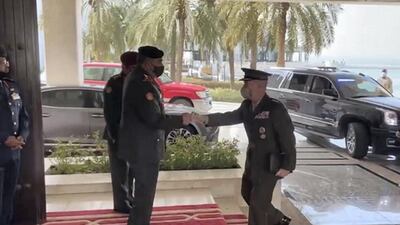Saudi Arabia, the US and the UK completed joint naval exercises in the Arabian Gulf.
Few details were released about exercise Naval Defender 21, although during the manoeuvres, the US sent B-52 bombers to the region, which were escorted by Saudi Arabian F-15s.
The heavy bombers, which began service in 1955, have undergone seen major upgrades since then, making their combat power almost unrecognisable compared with their first deployments in the Vietnam war.
The US Air Force recently began fitting the bombers with 20 AGM-158 joint air-to-surface standoff missiles, stealthy weapons able to engage targets almost 1,000 kilometres away.
The B-52 deployment and the naval exercises, are aimed at deterring Iran from testing the resolve of the US and allies as diplomatic options are explored to end the stand-off on Iran's nuclear programme.
At the end of 2020, UK and US naval forces took part in minesweeping practices, suggesting recent operations, including the exercise, are aimed at ensuring freedom of movement in the Arabian Gulf, in particular the Strait of Hormuz.
Analysts have long feared that in the event of a war involving Iran, Tehran could seek to block the narrow strait with naval mines.
Brig Gen Awad Al Enezi, the Saudi Arabian general in charge of the exercise, said practices were aimed at ongoing threats in the region’s waters – participating forces practised boarding suspect vessels, firing at moving targets on water, countering drones and protecting ports.
To varying extents, these skill sets are in increasing demand in the region, because forces such as the Islamic Revolutionary Guard Corps in Iran have long relied upon large fleets of small, fast boats, as well as working on an array of combat drone designs, some of which they have supplied to regional militias.
Special forces from Saudi Arabia and the US also took part in the exercises.
The operation led to “many positive results that reflect the importance of continuous training,” said Brig Gen Al Enezi.
Naval Defender 21 followed joint exercises between the UAE and the US last week, aimed at strengthening military co-ordination between the two allies.
As the exercises were under way, US Adm Kenneth McKenzie, who heads the US Central Command – the general headquarters for US forces in the Middle East – visited Kuwaiti Prime Minister Sabah Al Khalid Al Sabah to discuss regional co-operation.


